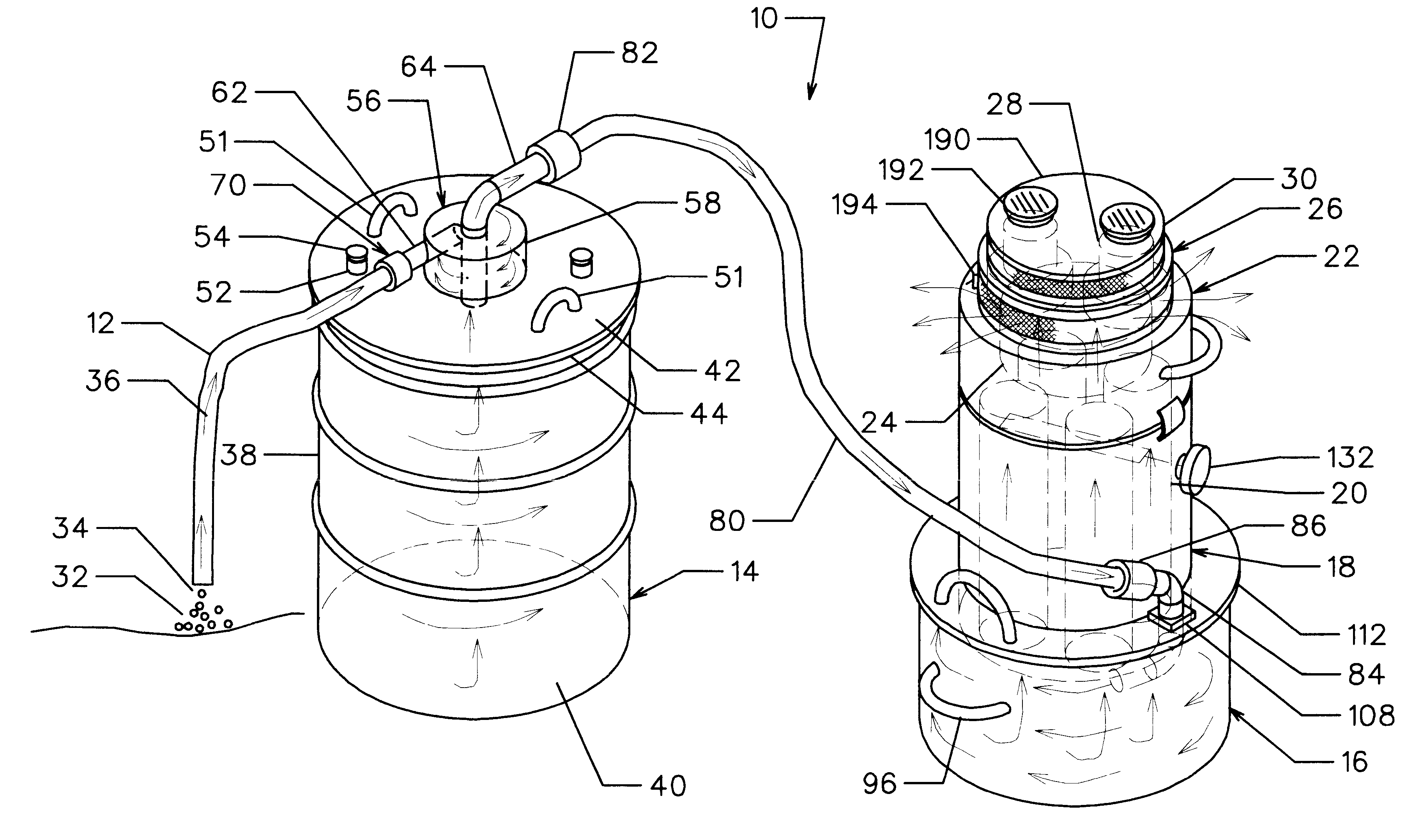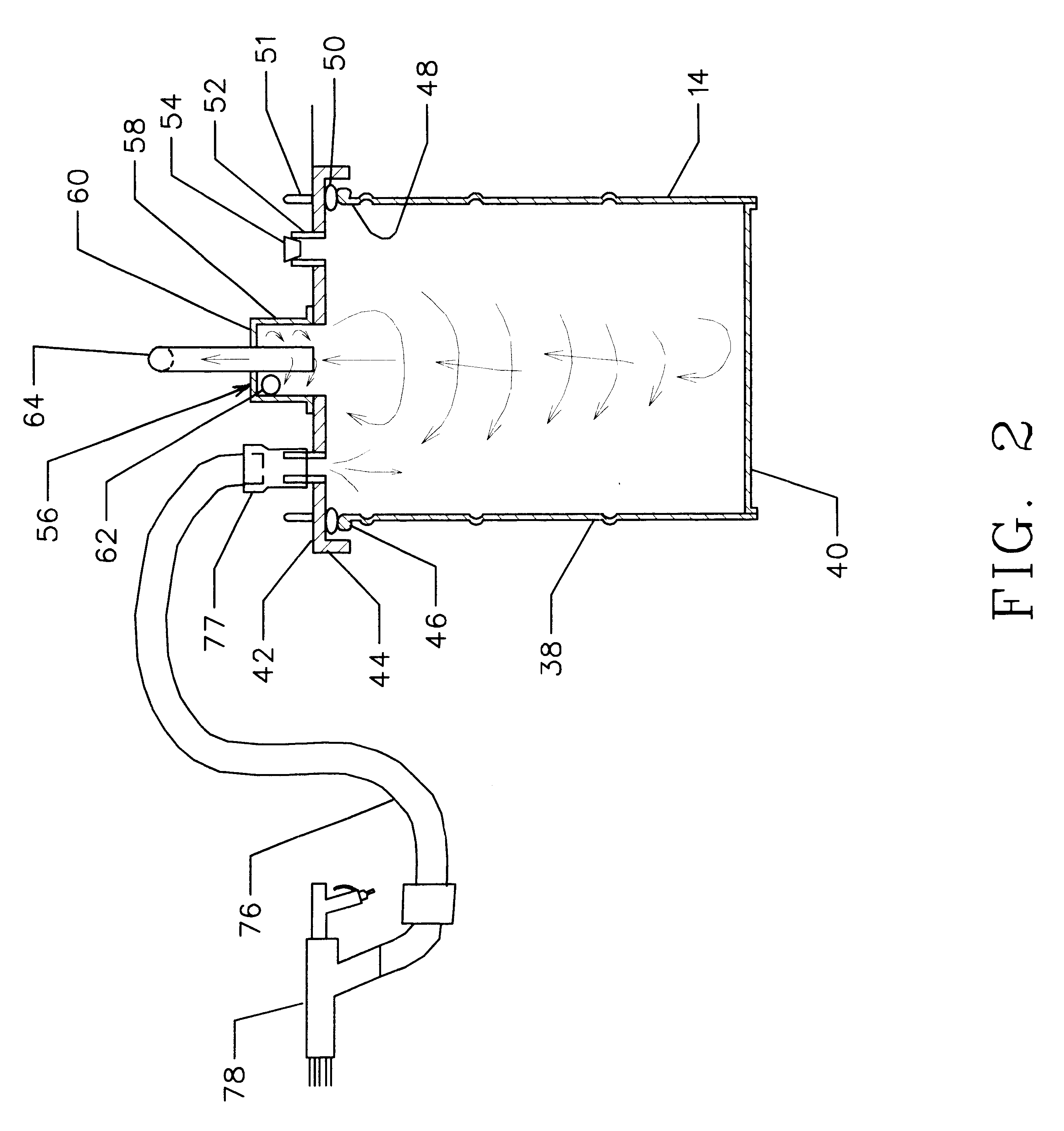Polycyclonic vacuum collectors for virtually non-stop environmental remediation
a vacuum collector and polycyclonic technology, applied in the field of vacuum collectors, can solve the problems of unsuitable vacuum loaders for challenging operations, unsuitable unsuitable vacuum loaders for rapid, efficient cleaning of heavily contaminated areas, etc., to maximize collector efficiency and capacity, high contaminant processing capability, and high contaminant storage capacity
- Summary
- Abstract
- Description
- Claims
- Application Information
AI Technical Summary
Benefits of technology
Problems solved by technology
Method used
Image
Examples
embodiment 10
Preferred embodiment 10 of the invented polycyclonic vacuum collector, shown in FIG. 1, is bicyclonic, comprising a vacuum hose 12, a first drum 14, a second drum 16, a primary filter housing 18 containing primary filters 20, a HEPA filter housing 22 containing a HEPA filter 24, a motor housing 26 containing two motors 28, and a motor cover 30. Vacuum hose 12 communicates with first cyclonic drum 14, which communicates with second cyclonic drum 16, which communicates primary filter housing 18, which communicates with HEPA filter housing 22, which communicates with motors 28. The purpose of motors 28 is to pull a vacuum. When the motors pull a vacuum, a negative pressure develops inside collector 10, i.e., the pressure inside the collector is lower than the pressure outside, which pressure difference enables vacuum hose 12 to suck air from the atmosphere mixed with contaminants 32 on a surface under open end 34 of vacuum hose 12. This suction produces a flow of contaminant-laden air ...
embodiment 196
Additional embodiment 196 of the present invention, shown in FIG. 10, is the preferred embodiment of FIG. 1 with this difference: interposed between and communicating with first and second cyclonic drums 14 and 16 is a cyclonic drum 198 taken from the prior art. Cyclonic drum 198 has a cyclone generator 200. The cyclone generator 200 shown in FIG. 10 has a helical roof; it is a prior art cyclone generator and can, e.g., be replaced by any of the prior art cyclone generators shown in FIG. 11. Helical-roof cyclone generator 200, as well as those of FIG. 11, are discussed in Design of Industrial Ventilation Systems, J. L. Alden and J. M. Kane, Industrial Press Inc., New York, N.Y. 1982. Cyclone generator 200 of FIG. 10 has a side wall with a cylindrical upper section 202 and a conical lower section 204, a top wall 206, an inlet port 208, a bent outlet port 210, and a helical roof 212 inside the space defined by cylindrical upper section 202. Conical lower section 204 has an opening 211...
embodiment 224
Alternative embodiment 224 shown in FIG. 12 modifies the preferred embodiment of FIG. 1 by interposing between and connecting with first cyclonic drum 14 and second cyclonic drum 16 n-2 communicating cyclonic drums, where n is an integer greater than 3. In FIG. 12, C.sub.1 represents the first cyclonic drum 14 of FIG. 1 connected to a vacuum (suction) hose 226; C.sub.n represents the second cyclonic drum 16 of FIG. 1 carrying the stack of (a) primary filter housing 18 containing primary filter bags 20, (b) HEPA filter housing 22 containing HEPA filter 24, (c) motor housing 26 containing motors 28, and (d) motor cover 30. Cyclonic drums C.sub.2 and C.sub.m are known in the art, e.g., they can be assembled using drums and the cyclone generators of FIG. 11. Dots 228 between symbols C.sub.2 and C.sub.m, and between C.sub.m and C.sub.n represent additional prior art cyclonic drums, which are part of the chain of communicating cyclonic drums of the polyccyclonic assembly 224. Lines 230 re...
PUM
| Property | Measurement | Unit |
|---|---|---|
| Angle | aaaaa | aaaaa |
| Angle | aaaaa | aaaaa |
| Power | aaaaa | aaaaa |
Abstract
Description
Claims
Application Information
 Login to View More
Login to View More - R&D
- Intellectual Property
- Life Sciences
- Materials
- Tech Scout
- Unparalleled Data Quality
- Higher Quality Content
- 60% Fewer Hallucinations
Browse by: Latest US Patents, China's latest patents, Technical Efficacy Thesaurus, Application Domain, Technology Topic, Popular Technical Reports.
© 2025 PatSnap. All rights reserved.Legal|Privacy policy|Modern Slavery Act Transparency Statement|Sitemap|About US| Contact US: help@patsnap.com



